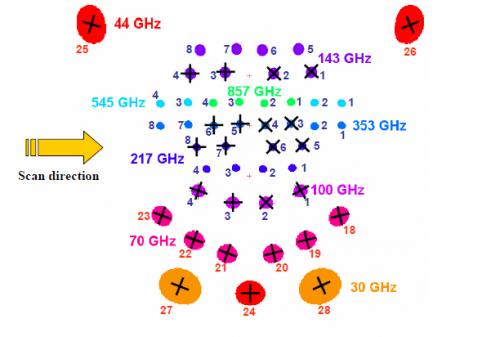Detector pointing
Contents
[hide]Introduction and Summary[edit]
The overall geometry of the Planck focal plane is shown here:
In order to take full advantage of the Planck beams, we must know the individual detector pointing positions to a precision of better than several arcseconds, over the course of the entire mission.
Spacecraft pointing comes from the on-board star tracker sampled at 8 Hz between repointings (Attitude History File, AHF). This is translated via a series of three-dimensional rotations to a pointing for the centre of the focal plane and resampled to the HFI or LFI TOI data rate for convenience. We must then further rotate this focal-plane boresight pointing to the individual detector locations. Because neither the rotations from the star tracker to the boresight nor those from the boresight to the individual detectors are known exactly a priori, we must calibrate them using flight data.
Specifically, measurements of HFI and LFI detector pointing are based largely on observations of the brighter planets, with information from the much more frequent observations of lower-flux Galactic and extragalactic high-frequency sources used to monitor and build a model of overall pointing drift. This long-term drift of the spacecraft attitude is due to changes in the moment of inertia of the spacecraft, and also includes specific events which may induce sudden changes, essentially random as far as our ability to predict their effects is concerned. In this delivery HFI used a model (described below) to follow the pointing drift continuously, while LFI uses two different focal plane descriptions for the two time periods separated by operations perfomed on the instrument that modified the thermal behaviour. The two approach are consistent to better than a few arcsec.
Note that for HFI the resulting pointing model cannot easily be directly compared to a physical/optical model: in particular, it includes a phase shift in the scan direction from the convolution and deconvolution of the detector transfer function, which is complex in the Fourier domain (see Planck-2013-VII[1]). This phase shift was not measured during normal operations, but a short campaign during which the spacecraft was spun at a higher rate will be used to determine these offsets in future date releases. Comparison with the initial optical model indicates that the in-scan change due to this phase shift is of the order of 1 arcminute. Note also that aberration is corrected in all observations.
The final pointing model is measured to be better than 2 arcsecond rms in the co-scan and cross-scan directions averaged over ten-day periods, as shown below. Note that there are larger hourly drifts of up to 10 arcseconds due to interference from the radiometer electronics box assembly (REBA) as discussed more fully in Planck-2013-VI[2].
Stellar Aberration[edit]
The corrected quaternions are interpolated using Spherical Linear Interpolation algorithm and transformed in cartesian vector, which we call . For each sample the stellar aberration correction is applied:
where is the satellite velocity and is the speed of light. After this operation the vector is normalized.
Finally the cartesian vetor is converted in Ecliptic Coordinates, the detector pointing.
Beam Rotation[edit]
The rotation of the beam with respect to North is the angle and is computed rotating the corrected quaternions .
The resulting rotation matrix represents the rotation of the beam, the angle is then:
Focal plane drift[edit]
The low frequency pointing correction, known as PTCOR has been reworked to include satellite "wobble" angle corrections (difference between the satellite spin frame and the rigid body reference frame). The move was necessitated by problems in the measured wobble angles beyond the HFI mission (beyond survey 5). We also observed that the long time scale features in the pointing correction were very well fitted by a template constructed from the solar distance. This template was further augmented by including a linear fit component and breaks at times of known thermal disturbance onboard the spacecraft.
References[edit]
- Jump up ↑ Planck 2013 results. VII. HFI time response and beams, Planck Collaboration, 2014, A&A, 571, A7
- Jump up ↑ Planck 2013 results. VI. High Frequency Instrument Data Processing, Planck Collaboration, 2014, A&A, 571, A6
Attitude History File
(Planck) High Frequency Instrument
(Planck) Low Frequency Instrument
LFI Radiometer Electronics Box Assembly


